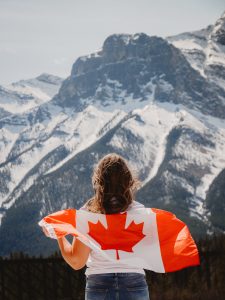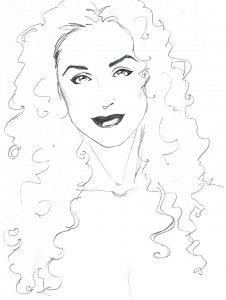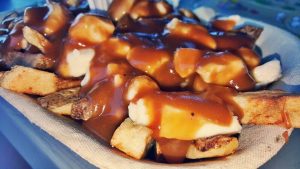45 N America: Cultural Geography III – Canadian Culture and America
“If some countries have too much history, we have too much geography.”
– William Lyon Mackenzie King, statesman and former prime minister of Canada
 In Chapter 3, we state that the term culture refers to collective, learned human behavior. Indeed, culture essentially is the way of life of a group of people. The major core components of culture are language, religion, and ethnicity, but culture also includes social relations, political systems, economic activities, and more. As a result, Canadian culture is often generalized in textbooks as English-speaking (with French dominant in Quebec), Christian (mostly Catholic and Protestant), with a parliamentary system, and a mostly service-based economy. However, this is a short list, yet a very broad summary. A similarly incomplete parallel would be characterizing the United States simply as English-speaking, Christian, democratic, and economically service-based. Therefore, let’s go beyond a cursory summary to examine a few geographic aspects of Canada’s culture in relation to the United States.
In Chapter 3, we state that the term culture refers to collective, learned human behavior. Indeed, culture essentially is the way of life of a group of people. The major core components of culture are language, religion, and ethnicity, but culture also includes social relations, political systems, economic activities, and more. As a result, Canadian culture is often generalized in textbooks as English-speaking (with French dominant in Quebec), Christian (mostly Catholic and Protestant), with a parliamentary system, and a mostly service-based economy. However, this is a short list, yet a very broad summary. A similarly incomplete parallel would be characterizing the United States simply as English-speaking, Christian, democratic, and economically service-based. Therefore, let’s go beyond a cursory summary to examine a few geographic aspects of Canada’s culture in relation to the United States.
As defined here or elsewhere, ethnicity is strongly related to culture, but the basis of ethnicity is belonging to a group, sharing its culture or sub-culture, and identifying with it. Members of large populations may share many aspects of culture, but smaller groups within the whole will have different histories and ancestries (e.g., migrants) and therefore claim a more specific identity.
Canada has a population of nearly 38 million people, placing it 38th among countries of the world, according to www.worldometer.info. Canada is very slightly behind Poland in these numbers. Poland is the size of New Mexico in area and is 98% Polish in ethnicity.
In contrast to Poland, Canada has roughly the area of the whole United States. Unlike Poland, but similar to the United States, Canada features many ethnic groups. Some ethnicities there connect with the original French and British colonists and with later migrations of European peoples. Others are native peoples – Inuits and First Nations. There are smaller distinctive ethnic migrant groups like the Doukhobors (from Russia). Statistics Canada now recognizes over 250 ethnic groups across the country. Whereas we might be able to summarize the 38 million people of Poland into a somewhat cohesive group, it is difficult to do that for Canada.

With a land area the size of the United States that stretches from the Pacific Ocean to the Atlantic Ocean as does the USA, Canada features a diverse set of physical landscapes. Naturally, these landscapes affect the socioeconomic elements of those locations. Saying that Canadians are sort of like Americans is a very broad statement about both populations. It will be occasionally correct, but often incorrect. Instead, it is safer to contend that people of British Columbia are similar to the people of Washington state. These are adjacent regions with similar climates. Asian populations tally as the largest minority populations in both regions. Also, Nova Scotia or New Brunswick may be compared to Maine as neighboring regions – small, forested, coastal lands each with modest populations somewhat near one million people.
Here are three key factors that bring Americans and Canadians together. One, geographically, ninety percent of Canadians live within 150 miles of the border with the United States. As we know from Tobler’s First Law of Geography – “Everything is related to everything else, but near things are more related than distant things,” certainly there will be characteristics that Canadians share with Americans and there will be ways that the two countries interact. One example can be seen in this striking map of British Columbia – https://www.reddit.com/r/MapPorn/comments/i6ser7/british_columbia_split_into_3_areas_of_equal/
Two, these connections are aided by the longest international land border in the world. Furthermore, the border is a friendly border with few and minor conflicts. Length and cooperation make it easy for trade and travel between the two countries. In fact, the United States exports more goods (measured by $) to Canada than it does to any other country in the world. Over half of Canada’s exports go to the USA. The United States provides 80% of all foreign visitors to Canada, while Canadians are over 25% of travelers visiting America – that ranks #1 also.
Three, both official languages of Canada are dialects of Europe-based languages. Most importantly for the American connection, over 85% of Canadians speak English. Canadian French (called joual in Quebec) developed from 1760’s French (after which the British conquered Canada) and has different pronunciations, contractions, and English loanwords (e.g., ski-doo) than Parisian French does. Canadian English is sometimes spelled like British English, sometimes like American English; the same holds true for pronunciation and vocabulary, although there are also “Canadianisms.” For example, Canadians use British words such as loo and porridge; American words such as TV and gas; and their own words such as toques – particular knitted winter caps, loonies – dollar coins that have a loon pictured on one side, and ridings – electoral districts.
Thus, it is not surprising that America and Canada share many interests, while having their own differences. Now on the very broad topic of popular culture, let’s make three more observations.
 Geography clearly has influenced sports in Canada. Hockey makes sense in a cold outdoorsy setting. Canadian James Creighton is considered as the father of indoor hockey, organizing an official match indoors in 1875. By law, the country has two declared national sports: ice hockey in winter and lacrosse in summer. Canada has its own variation of American football. The Toronto Raptors won the 2019 NBA championship. Curling is less well known, but along with ice-skating is part of Canada’s winter sports culture.
Geography clearly has influenced sports in Canada. Hockey makes sense in a cold outdoorsy setting. Canadian James Creighton is considered as the father of indoor hockey, organizing an official match indoors in 1875. By law, the country has two declared national sports: ice hockey in winter and lacrosse in summer. Canada has its own variation of American football. The Toronto Raptors won the 2019 NBA championship. Curling is less well known, but along with ice-skating is part of Canada’s winter sports culture.
Canadian television and radio are supported by the government. In part, the Canadian Radio-television and Telecommunications Commission (CRTC) ensures Canadian content, but still there is tremendous overlap with American popular TV. The streaming content of the contemporary world crosses borders easily, so that American shows are seen in Canada, while Canadian series may be viewed in America. Toronto and Vancouver are vibrant sites for movie and television production and filming. Canadian actors and actresses are common in the US, often to the ignorance of American viewers who perceive the performers as being American.

Drawing by Michelle Delecki.
A particularly geographic show on Canadian television was “The Border,” which highlighted international issues. Of course, the show (CBC, 2008-2010) referred to the USA-Canada border; thus, plots often presented contrasting American and Canadian viewpoints and strategies. Naturally, the show featured a Canadian cast, though a Homeland Security agent liaising with Canadian authorities was played by American actress Sofia Milos. “The Border” can be streamed free on Amazon Prime.
Americans in Canada will not find huge differences in cuisine; yet, some foods are distinctly Canadian. In 2013, The Huffington Post – Canada listed poutine (French fries slathered in gravy and cheese curds) first in its article on fifty of the most Canadian foods.

Globe and Mail newspaper’s restaurant critic Dan Clapson states, “Our country’s most iconic dish internationally is, by far, the poutine.” However, poutine in Canada is not dished up in a geographically even manner, as the food is more common in eastern regions. Having originated in Quebec province, poutine is an element of Québécois culture, so that its spatial diffusion has occurred from that eastern Canadian region.
Did You Know?
Canadians are nicer than Americans. Well, at least on Twitter, a research study suggests. Geotagged tweets were compiled to create word clouds of the most commonly used words in these social media comments. The American word cloud showed more words blurred out, meaning that these were offensive words.
Equality, equity, and social justice were the top three Canadian values according to a Nanos Research survey in 2016. Politeness, informality, and tolerance are also listed in various magazine articles and news stories as being very Canadian. The acronym POGG (for Peace, Order, and Good Government) has been shorthand for Canadian values ever since the British North American Act of 1867 that established Canada. Unlike the US, Canada did not revolt from the United Kingdom, but legally separated from it and did not claim the need for “life, liberty, and the pursuit of happiness.”
The last letter in the English language is z. In Canadian English this letter is known as “zed.” That may seem strange to Americans; however, across the world in various forms of the English language that last letter is zed. American English is the oddball case, calling that letter “zee.”
The amount exported in dollars by the United States to Canada is equivalent to the amount exported to all the European Union countries combined.
Actor William Shatner is a Canadian, but his most famous character is Star Trek’s Captain James T. Kirk, who was born in Iowa.
The comedy trio Foil, Arms, and Hog have video series mocking immigration checkpoints. Go here to see their take on Canada. FoilArmsHogCanada
The second longest international land border in the world is between Russia and Kazakhstan.
For a comparison between Thanksgiving in the United States and in Canada, read this article – https://www.nationalgeographic.com/history/article/canadian-american-thanksgiving-different?cmpid=org=ngp::mc=crm-email::src=ngp::cmp=editorial::add=Compass_20211120::rid=0C8C5572F06CD45A47C78F5EE832FA24
In 2014 Thrillist suggested that s’mores are the most American food.
This chapter was co-written by Joel Quam and Peter Meserve.
Cited and additional bibliography:
Childers, Liz. 2014. “Ranking the 50 Most American Foods.” Thrillist. Thrillist. June 30, 2014. https://www.thrillist.com/eat/nation/power-ranking-the-most-american-foods.
Clapson, Dan. 2019. “Where to Eat Poutine around the World.” Eat North. January 11, 2019. https://eatnorth.com/dan-clapson/where-eat-poutine-around-world.
Delecki, Michelle. 2016. Sofia Milos.
“Exploring Canadian Values.” 2016. https://www.nanos.co/wp-content/uploads/2017/07/2016-918-values-populated-report-w-tabs-r.pdf.
Kliff, Sarah. 2016. “Finally! Science Proves That Canadians Are Way More Polite than Americans.” Vox. January 7, 2016. https://www.vox.com/2016/1/7/10729110/canadians-polite-twitter.
National Sports of Canada Act. 1994. Vol. SC1994, c16. https://laws-lois.justice.gc.ca/eng/acts/n-16.7/page-1.html.
Patel, Arti. 2013. “Canadian Food: The Most ‘Canadian’ Foods Include Bacon, Poutine And Maple Syrup.” HuffPost Canada. HuffPost Canada. March 18, 2013. https://www.huffingtonpost.ca/2013/06/28/canadian-food_n_2869764.html.
Pearson, Steve. 2009. “History of Ice Hockey From Early Beginnings to Current.” Thepeoplehistory.Com. 2009. http://www.thepeoplehistory.com/icehockeyhistory.html
Traci. 2017. Poutine. https://tinyurl.com/poutine2017. Attribution-NoDerivs 2.0 Generic (CC BY-ND 2.0).


